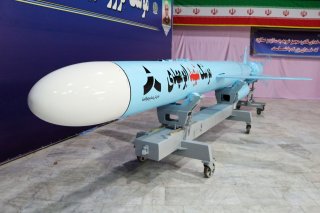Yes, Iran's Ballistic Missiles Are Pretty Accurate
Tehran has demonstrated this time and again.
Key Point: Iran's missiles are one of its finest military programs. Washington is right to be concerned about what Tehran could do with them.
The images paint a picture of precision: The first satellite imagery of the aftermath of the Iranian strike on Ayn al-Asad Air Base in Iraq highlights Iran's improved ability to accurately strike distant targets with its extensive missile arsenal. The pictures, released by imaging company Planet Labs on Jan. 8, show that Iran can chalk up its strike as a success even without inflicting U.S. casualties. What's more, they also show how Iran sought to skirt a delicate line in exacting public retribution while also avoiding an escalation that would lead to outright war.
The Aftermath of a Strike
According to reports, Iran fired around 16 short-range ballistic missiles at two bases with a U.S. presence in Iraq, Ayn al-Asad and Arbil International Airport. Tehran appears to have launched several of its less reliable Qaim 1 missiles at Arbil, though many of them apparently failed to hit their target. Still, the brunt of Iran's attack was Ayn al-Asad, which was hit by about 10 of Iran's more reliable Fateh-110 missiles (and possibly its more modern Fateh-313 variant).
The images from the aftermath at Ayn al-Asad illustrate the significant potency of the missiles that hit the base. The pictures reveal at least eight impact sites, with most appearing to have caused considerable damage to hangars and soft aircraft shelters that might have contained American jets or other aircraft. One of the strikes, for instance, appears to have hit soft aircraft shelters that housed CV-22 Ospreys, almost certainly causing at least some damage to aircraft. A separate impact appears to have hit another row of soft aircraft shelters containing helicopters, while another seems to have struck a hangar or machine shop used to service American unmanned aerial vehicles — a highly symbolic target given that these were potentially the same drones that the United States used to kill senior Iranian military leader Qassem Soleimani last week.
What the Pictures Mean
The lack of American casualties — despite the accuracy of the Iranian missiles — likely stems from two factors. First, Tehran appears to have made a deliberate decision to destroy equipment rather than kill American personnel. That is not to say that Iran wanted to absolutely avoid killing American service members in the strike — after all, no such operation could have eliminated that risk entirely. But the concentration of the hits on the aircraft and their support shelters, instead of the base's housing facilities, lays bare what Tehran was gunning for in the operation.
Second, the United States received ample warning of the incoming strike, allowing U.S. troops to shelter in bunkers and ride out the storm. The advanced warning reportedly included information from Iraq, which passed along news of the imminent attack that it had received from Iran, as well as notification from the United States' own early-warning systems, such as radars and satellite surveillance.
The nature of Iran's attack, the target set, the relatively limited number of missiles (despite Tehran's vast ballistic missile arsenal) and its subsequent signals to the United States that it intends to stand down all suggest that Tehran simply wanted to send a powerful message to the United States while minimizing the risk of a significant U.S. counterstrike. Of course, the Iranian operation could have incited a furious U.S. response if it had killed American soldiers, but Tehran made it abundantly clear that it wanted to make a show of its retaliation without touching off an outright war.
The Upshot
The September 2019 attack on Saudi Arabia's Abqaiq and Khurais oil facilities, as well as the assault on Ayn al-Asad, illustrate how Iran retains potent capabilities even if its conventional military technology remains woefully outdated. Tehran's efforts to bolster its asymmetric capabilities in recent decades by investing in militias and weapons like cruise and ballistic missiles ensure that it retains the ability to inflict considerable damage on many in the region, even an adversary as powerful as the United States. This, coupled with Iran's strategic geographic proximity to critical energy fields and global energy supply lines, gives the country a great deal of leverage in both deterring and coercing its adversaries.
With Its Missile Strikes, Iran Flaunts Its Accuracy is republished with the permission of Stratfor Worldview, a geopolitical intelligence and advisory firm. This first appeared earlier in 2020 and is being reposted due to reader interest.
Image: Reuters.

